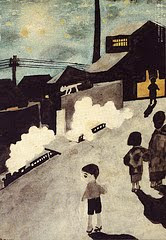

Experiences in Japanese Culture & Society ~ The Meji Era through The Lost Decades.
 The watercolor illustration you see at the top of the National Highway page was made by the Japanese illustrator Mistumasa Anno. Throughout his artistic career he accomplished a truly awe-inspiring number of children's picture books, the most famous of which is perhaps Anno's Journey. Most often, the books detail a traveler's journey through a foreign land.
The watercolor illustration you see at the top of the National Highway page was made by the Japanese illustrator Mistumasa Anno. Throughout his artistic career he accomplished a truly awe-inspiring number of children's picture books, the most famous of which is perhaps Anno's Journey. Most often, the books detail a traveler's journey through a foreign land.

I noticed earlier today the library materials I checked out from school last month were to be returned tomorrow. I had already long-decided they were too difficult for me so I thought today I would return them in exchange for something just a little bit easier.
Kawaguchi-san is the school librarian. I found out today her daughter lives a few hours west of Buzen in Nagasaki City. She and I spoke in formal Japanese these last two meetings, and I have a feeling our relationship will continue this way. I'm very happy speaking formally with certain people. Formal language has the power to elevate ordinary experiences from the mundane to what feels like ceremonial rites. I decided after today the two of us speak formally because we have a certain mutual appreciation for one another. Without the reader what is the librarian? A good librarian is the best asset for the reader, much better than a database or search engine. Kawaguchi-san is very good at what she does.
I checked out two books today. One is a collection of songs and poetry by Kitahara Hakushu, the other is a book of poetic explorations in wordplay by Tanikawa Shuntaro. Thank you Kawaguchi-san!

